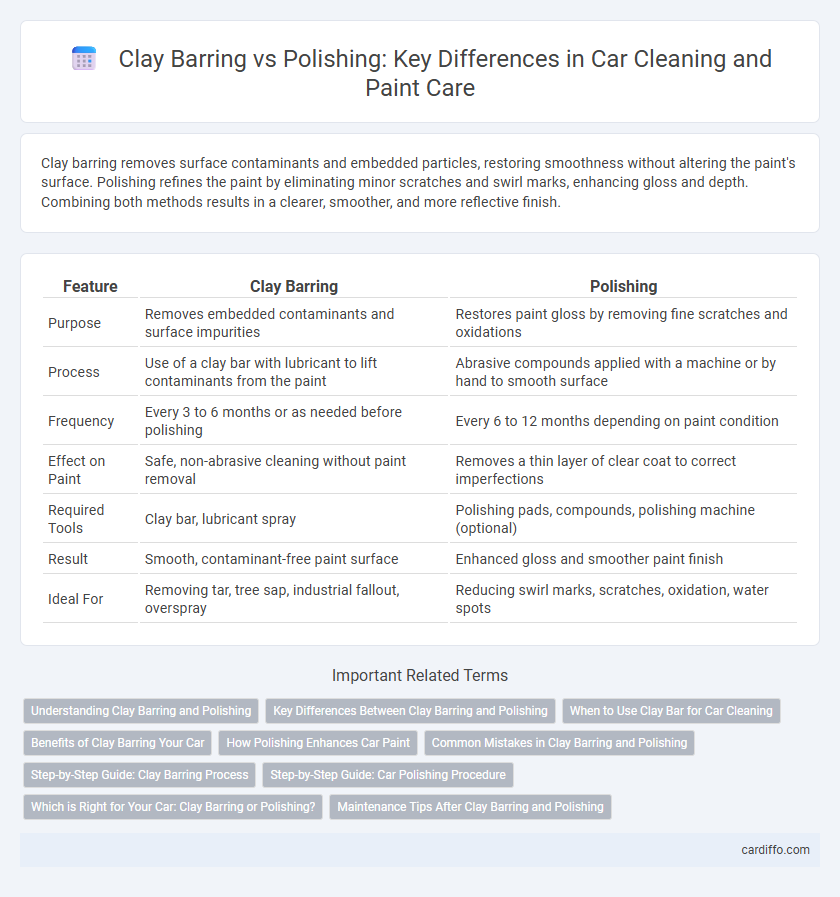Clay barring removes surface contaminants and embedded particles, restoring smoothness without altering the paint's surface. Polishing refines the paint by eliminating minor scratches and swirl marks, enhancing gloss and depth. Combining both methods results in a clearer, smoother, and more reflective finish.
Table of Comparison
| Feature | Clay Barring | Polishing |
|---|---|---|
| Purpose | Removes embedded contaminants and surface impurities | Restores paint gloss by removing fine scratches and oxidations |
| Process | Use of a clay bar with lubricant to lift contaminants from the paint | Abrasive compounds applied with a machine or by hand to smooth surface |
| Frequency | Every 3 to 6 months or as needed before polishing | Every 6 to 12 months depending on paint condition |
| Effect on Paint | Safe, non-abrasive cleaning without paint removal | Removes a thin layer of clear coat to correct imperfections |
| Required Tools | Clay bar, lubricant spray | Polishing pads, compounds, polishing machine (optional) |
| Result | Smooth, contaminant-free paint surface | Enhanced gloss and smoother paint finish |
| Ideal For | Removing tar, tree sap, industrial fallout, overspray | Reducing swirl marks, scratches, oxidation, water spots |
Understanding Clay Barring and Polishing
Clay barring involves using a specialized clay bar to remove surface contaminants like industrial fallout, brake dust, and overspray that washing alone cannot eliminate, resulting in a smooth and clean paint surface. Polishing, on the other hand, focuses on removing minor imperfections such as swirl marks, oxidation, and light scratches by gently abrading the clear coat with abrasives and polishing compounds. Understanding the distinct purposes of clay barring and polishing helps maintain a vehicle's finish, as clay barring prepares the surface by removing embedded contaminants, while polishing restores clarity and shine by refining the paintwork.
Key Differences Between Clay Barring and Polishing
Clay barring removes surface contaminants like tar, tree sap, and industrial fallout that washing alone cannot eliminate, restoring smoothness to paint. Polishing eliminates minor scratches, swirl marks, and oxidation by using abrasives to refine the clear coat, enhancing gloss and depth. Unlike polishing, clay barring does not alter paint thickness but prepares the surface for subsequent polishing or waxing steps.
When to Use Clay Bar for Car Cleaning
Clay barring is ideal for removing embedded contaminants such as industrial fallout, brake dust, and tree sap that traditional washing cannot eliminate, making it essential before polishing. Polishing primarily addresses surface imperfections like swirl marks and light scratches, so clay barring should precede to create a contaminant-free surface for effective polishing. Use a clay bar when your car's paint feels rough to the touch, indicating trapped dirt and particles that hinder paint clarity and smoothness.
Benefits of Clay Barring Your Car
Clay barring effectively removes embedded contaminants such as tar, tree sap, and industrial fallout that polishing alone cannot eliminate, resulting in a smoother and cleaner surface. This process enhances paint clarity and prepares the vehicle for polishing or waxing by creating a contaminant-free base. Regular clay barring extends the longevity of your car's paint finish by preventing surface imperfections and promoting better adhesion of protective coatings.
How Polishing Enhances Car Paint
Polishing enhances car paint by removing microscopic imperfections and oxidation, restoring a smooth and glossy surface that reflects light more effectively. It refines the paint's texture after clay barring, which removes contaminants but doesn't address swirl marks or minor scratches. The result is a deeper, more vibrant shine that extends the longevity and visual appeal of the vehicle's finish.
Common Mistakes in Clay Barring and Polishing
Common mistakes in clay barring include using excessive pressure, which can cause surface marring, and neglecting to properly lubricate the paint, leading to paint damage. In polishing, frequent errors involve applying too much polish, resulting in uneven finishing, and using the wrong pad type, which can create swirl marks and holograms. Both processes require careful technique and the correct materials to avoid compromising the vehicle's paint integrity.
Step-by-Step Guide: Clay Barring Process
Begin the clay barring process by thoroughly washing the vehicle to remove surface dirt and grime. Use a clay bar with a suitable lubricant, gently rubbing it over the paint in straight motions to lift embedded contaminants without scratching the surface. Rinse and dry the area after each section before proceeding to polishing for a smooth, contaminant-free finish.
Step-by-Step Guide: Car Polishing Procedure
Start by thoroughly washing the car to remove surface dirt and contaminants. Next, use a clay bar lubricated with a detailing spray to gently remove embedded particles from the paintwork, ensuring a smooth finish. Follow by applying a car polish with a dual-action polisher or by hand in small sections, then buff off with a microfiber cloth to restore shine and eliminate minor scratches.
Which is Right for Your Car: Clay Barring or Polishing?
Clay barring effectively removes embedded contaminants like tar, brake dust, and industrial fallout, restoring a smooth paint surface, while polishing corrects minor paint imperfections such as swirl marks and scratches by removing a thin layer of clear coat. Choosing clay barring is ideal for cars with rough or contaminated paint, whereas polishing suits vehicles needing enhanced gloss and surface refinement. Assess your car's paint condition to determine whether contaminant removal or paint correction aligns best with your detailing goals.
Maintenance Tips After Clay Barring and Polishing
After clay barring, it is essential to wash the vehicle thoroughly to remove any residual clay and contaminants, preventing swirl marks and maintaining a smooth surface. Post-polishing, apply a high-quality wax or sealant to protect the clear coat from UV damage and environmental contaminants, prolonging the shine and durability. Regular maintenance using gentle, pH-balanced car shampoos and microfiber towels helps preserve the effects of both clay barring and polishing sessions.
Clay barring vs Polishing Infographic

 cardiffo.com
cardiffo.com